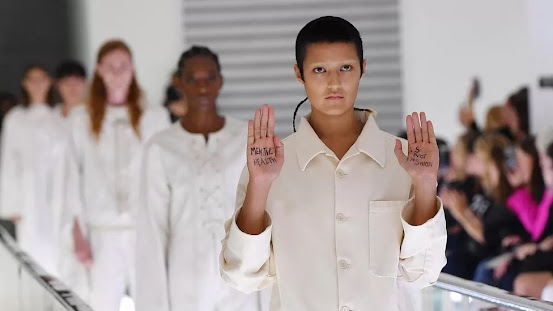Balaclava (pronounced bal-uh-klah-vuh)
(1) A
close-fitting, knitted cap that covers the head, neck, and tops of the
shoulders, worn especially by mountain climbers, soldiers, skiers and others
who operate in cold climates.
(2) A fire-resistant had covering in the style of the traditional balaclava but made of treated material.
1880-1885;
named after Balaklava, a village near
Sebastopol, Russia, site of a battle on 25 October 1854, during the Crimean
War (1853-1856). However, the term describing the headwear does not appear before
1881 and seems to have come into widespread use only during the Boer War, some
half a century after the battle. The
name Balaklava often is thought to be
of Turkish origin, but is perhaps folk-etymologized from the Greek original, Palakion.
The Charge of the Light Brigade
In many courses in organizational management, the events which led to the charge being ordered are used as a case-study in the breakdown of communications systems and how such processes should be designed to include failsafes. Long
regarded as a military failure, in recent decades, there’s been a body of
literature by military historians suggesting the charge was a key incident in
helping Britain to secure ultimate victory in the Crimea. It's not a universally accepted view but it's certainly true many battles in the world
wars of the twentieth century achieved less at greater cost.
The Charge of the Light Brigade (1854) by Alfred, Lord Tennyson (1809-1892)
Half a league, half a league,
Half a league onward,
All in the valley of Death
Rode the six hundred.
“Forward, the Light Brigade!
Charge for the guns!” he said:
Into the valley of Death
Rode the six hundred.
“Forward, the Light Brigade!”
Was there a man dismay’d?
Not tho’ the soldier knew
Some one had blunder’d:
Theirs not to make reply,
Theirs not to reason why,
Theirs but to do and die:
Into the valley of Death
Rode the six hundred.
Cannon to right of them,
Cannon to left of them,
Cannon in front of them
Volley’d and thunder’d;
Storm’d at with shot and shell,
Boldly they rode and well,
Into the jaws of Death,
Into the mouth of Hell
Rode the six hundred.
Flash’d all their sabres bare,
Flash’d as they turn’d in air
Sabring the gunners there,
Charging an army, while
All the world wonder’d:
Plunged in the battery-smoke
Right thro’ the line they broke;
Cossack and Russian
Reel’d from the sabre-stroke
Shatter’d and sunder’d.
Then they rode back, but not
Not the six hundred.
Cannon to right of them,
Cannon to left of them,
Cannon behind them
Volley’d and thunder’d;
Storm’d at with shot and shell,
While horse and hero fell,
They that had fought so well
Came thro’ the jaws of Death,
Back from the mouth of Hell,
All that was left of them,
Left of six hundred.
When can their glory fade?
O the wild charge they made!
All the world wonder’d.
Honor the charge they made!
Honor the Light Brigade,
Noble six hundred!
Balaclavas (some lightweight versions of which are usually called ski masks) are a type of (often knitted) cloth headgear which expose only part of the face, usually the eyes, mouth and sometimes the nostrils, thus protecting most of the skin’s surface area. The more elaborate versions are adjustable and some can be rolled to become a hat or worn around the neck. Although associated with use during the Crimean War, such garments had long existed and it was only contemporary publicity which led to the name being linked. The war in Crimea coincided with the advent of convenient, portable cameras and large volumes of photographs produced, making it the first large-scale conflict thus documented. The military at the time didn't appreciate the implications of journalists and photographers being able freely to report from battle zones and not for some time was it realized just how much intelligence the Russians were able to obtain simply be reading the London newspapers. It was in some of these early images that the headwear first attracted attention although it wasn’t until the 1880s that "balaclava" (and “balaclava helmet”) came into use and it became a common term only early in the twentieth century, the popularity thought to have been encouraged by the widely published photographs of the polar expeditions to which were a feature of late Victorian explorations.
Camila Cabello (b 1997) in Vetements balaclava in black, Paris Fashion Week, September 2024.
For warmth, British troops wore knitted woolen versions of the headwear, which, early in the war were all handmade, knitted either on the spot (a kind of on-board cottage industry emerging on Royal Navy ships anchored nearby, knitting a commonly held skill of sailors) or sent from home in response to sketches sent in letters. Later, knitwear companies would enter the market but the need existed only because poor planning and an under-estimation of the duration of the conflict meant most cold weather supplies never reached the troops. The Crimean War was a shock to the British Army which, organizationally, was little changed from the Battle of Waterloo (1815), two generations earlier and the findings of subsequent boards of inquiry resulted in worthwhile, if still inadequate, reforms. It was a not uncommon aspect of many colonial wars and exactly the same situation which confronted the Wehrmacht (the German armed forces, 1935-1945) in late 1941 when the harsh Russian winter arrived with the German advance still in open country, far from its objectives. Balaclava are most associated with protecting the face from the cold but relatively thin, lightweight versions versions made with fibres chemically treated to be fire-resistant are used in motor-racing (FIA 8856-2018 standard) and other fields where exposure to flame is an occupational hazard. They’re used also by both sides of the crime business to conceal identity; by criminals in an attempt to avoid detection and by those in law enforcement to protect themselves and their families from retribution.
Not all that appears on the catwalk catches on. Knitted balaclavas were a thing in some collections at fashion shows in 2018 but, not unexpectedly, a high-street trend didn’t follow.
PopSugar's distribution of Lindsay Lohan's "Masked Shoot" for Marc Ecko's (b 1972) Fall 2010 campaign, undertaken during blonde phase and including balaclavas, August 2010.










